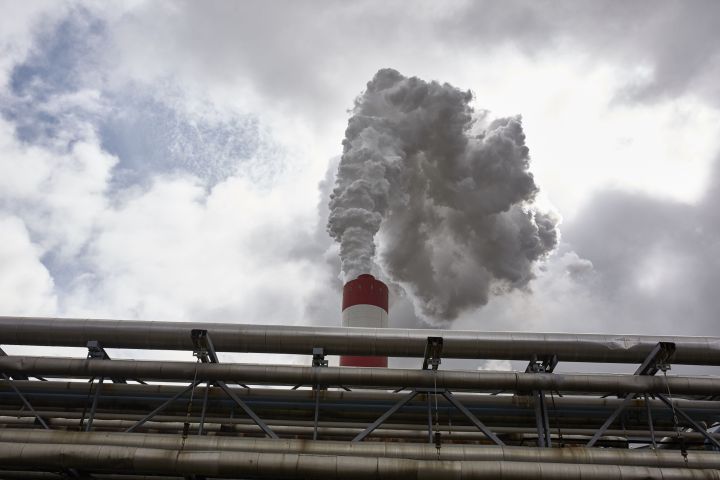Newsdeck
The First Commercial Carbon-Sucking Facility in the US Opens in California

The US is getting its first commercial facility to soak up carbon dioxide from the ambient air for permanent storage, a nascent technology that’s been both lauded as crucial in fighting climate change and derided as a distraction that will delay the clean energy transition.
The plant near San Francisco, built by Bay Area startup Heirloom Carbon Technologies, puts California at the forefront of the emerging carbon removal industry as a handful of so-called direct air capture (DAC) hubs are also slated to get underway. Heirloom’s facility, unveiled Thursday, will be capable of removing and storing as much as 1,000 tons of carbon dioxide each year.
That’s a pittance compared with bigger plants poised to come online in Texas and Louisiana, but it’s enough to serve as a milestone for a technology that’s likely to spawn a significant business. JPMorgan Chase & Co. and Google parent Alphabet Inc. are among the companies that have pledged hundreds of millions to buy carbon removal services, even as critics warn the industry will give oil producers an excuse to keep pumping crude.
Heirloom raised $53 million in a 2022 Series A round from investors including Microsoft’s Climate Innovation Fund and Bill Gates’ Breakthrough Energy Ventures. While Heirloom declined to disclose the price tag to build the California facility, the company aims to operate at a cost of $100 per ton of carbon removed by 2030 — a price point the young industry currently isn’t close to reaching.
Read More: How Carbon Capture Is Getting New Life With US Help
The Biden administration is throwing its weight behind the technology, too. In August, the Department of Energy announced the first wave of projects that won some of the $3.5 billion in funding for developing DAC hubs around the US. Though the Tracy facility is not a recipient of those dollars, Heirloom is part of one of those projects and its technology will be deployed at a major hub in Louisiana the government expects will remove 1 million tons of CO2 a year by the end of the decade. Heirloom and other DAC companies can also receive tax credits from the Inflation Reduction Act.
Research shows that gathering billions of tons of the greenhouse gas from the air each year by mid-century — in addition to rapid emissions reductions — will almost certainly be needed to limit global warming to 1.5C. Carbon capture and removal is “positioned to play an important role in decarbonizing the US economy,” according to BloombergNEF. The carbon market could reach $1 trillion by 2037 if rules prioritize high-quality removals, BNEF found in a separate analysis.
DAC, which is still in its infancy, uses vacuum-like machines to pull CO2 out of the atmosphere and store it using a variety of methods. Heirloom’s facility will use an electric-powered kiln to heat crushed limestone, transforming it into a calcium-based paste that’s spread onto stacked trays that act as carbon-absorbing sponges. Once saturated with the CO2, the material returns to the kiln, where the carbon is removed before the process repeats. The Tracy plant will store CO2 in tanks, though Heirloom and other companies plan to inject it deep underground for future projects. Heirloom has partnered with CarbonCure, a green concrete maker, to permanently store captured CO2 in the building material.
“We set out to develop a technology that avoided the typical cost associated with direct air capture,” said Noah McQueen, Heirloom’s head of innovation and co-founder. “That journey eventually led us to limestone. This rock has everything we need to capture millions and eventually billions of tonnes of carbon dioxide from the atmosphere. It’s safe, it’s found almost everywhere on Earth and it’s cheap.”
The facility’s technology differs from a more controversial method called carbon capture, which involves removing CO2 emitted at the smokestack. That technology can help decarbonize heavy industry, but oil companies have deployed it to capture CO2 then inject it underground to help extract more fossil fuels. The practice, known as enhanced oil recovery, has long been scrutinized by environmentalists who fear it could prolong the lifespan of fossil fuels. Occidental Petroleum Corp. — which is leading a DAC hub in Texas — has said sucking CO2 from the air is crucial to its strategy to keep producing oil.
Read More: An Oil Giant Quietly Ditched the World’s Biggest Carbon Capture Plant
Though Heirloom’s has said it won’t use its technology to perpetuate the fossil fuel industry, many environmentalists and local communities remain opposed to the technology as a whole due to safety concerns over ruptured pipelines and mass asphyxiation from leaks. They also worry state and federal leaders are taking a gamble on a technology that is largely untested and too expensive to operate. For reference, the largest DAC facility in the world, created by Swiss startup Climeworks, removes 4,000 tons of CO2 a year, an amount less than 270 average Americans’ annual carbon footprints.
“We’re very concerned,” said Katie Valenzuela, a policy advocate at the California Environmental Justice Alliance. “Direct air capture still carries all of the same concerns we have with carbon capture and without those safety measures in place, it’s going to have potentially really negative impacts on frontline communities.”
Read More: Carbon Removal Isn’t Just for Corporations. Individuals Are Paying For It, Too
Heirloom has sold a share of its carbon removal credits to various companies, including Microsoft, Stripe and Shopify. But Valenzuela is concerned that the company could participate in the Low Carbon Fuel Standard, a market system that allows carbon-intensive transportation companies to purchase credits instead of taking steps to use cleaner fuels, she said.
“It’s problematic because these credits will be used instead of reducing carbon at fossil fuel operations,” she added.
But research shows removing carbon from the atmosphere is necessary to realistically meet the US’s 2050 carbon-neutral target. California is also relying on capture and removal methods to eliminate about 100 million tons of CO2 annually to reach carbon neutrality by 2045. That could include other techniques to pull CO2 from the air, including adding crushed rocks to soil and zapping seawater. Beyond cleaning up carbon, policymakers tout that the budding industry will create thousands of high-income jobs for workers affected by the energy transition.
“Projects like this Heirloom facility are exactly the sort of big and innovative ideas that we’re embracing – using renewable energy to directly remove pollution from our air, all while creating good-paying jobs in the Central Valley,” Governor Gavin Newsom said in a statement.




















Fantastic news!
What a complete and totally utterly hair-brained, stupid, cretinous, dangerous, insane thing to do!!!!! We NEED CO2 people!!! It’s the gas of life, it’s what PLANTS need, it’s what greens the earth. Oh for goodness sake, when will people wake up to the truth about this CO2 scam?!
Ask the people pushing for this insanity “what is the percentage of CO2 in our atmosphere?” and they literally do not know. They quote some ppm number as though it means anything. CO2 is 0.04% of our upper atmosphere. And of that percentage, human produced CO2 is barely on the graph.
Yes, we have pollution and yes, we should clean up production systems/manufacturing systems but CO2 is NOT destroying our planet and is NOT causing “climate change”.
Correct – Carbon Monoxide is far worse, and lethal, than CO2 is (for sake of argument), and CO2 is required by plants for photosynthesis. CO2 is not the enemy … exhaust fumes, chemical fumes, pollution and rubbish heating up the oceans is!
Climate change is the biggest challenge facing mankind. Denial will not help anyone — only shot sighted short term profits of the fossil fuel industry.
This way of mitigating atmospheric CO2 and climate change costs about a hundred times as much as simply building solar and wind power plants.
Indeed, according to the authoritative IEA, building solar PV rather than coal fired plants SAVES more than half the cost of the power — IEA World Energy Outlook of 2021 already stated that with a good resource (and SA has the world’s best) and appropriate financing “solar PV gives the lowest cost electricity IN HISTORY”.
Long term BINDING wind and solar PV power contracts in SA’s REIPPPP (renewable energy independent power producer procuring project) cost around R0.50 – R0.50 in the latest bid window, against about three times as much for new coal-fired power from Medupi & Kusile.
Gradually (but not too slowly) switching to clean rather than CO2 emitting power is a far more cost-effective way of mitigating climate change than “sucking” CO2 from the air. Anyone who understands entropy knows this.
Despite solar and wind power being MUCH more affordable, our corrupt, misled and mismanaged energy dept still favours the hideously expensive polluting and climate changing coal option from which discerning companies & govts are turning.
It would be a pity if people committed $3,5B without getting their facts straight first.
Louiselouise, you are totally out of line with this (and previous similar) comments. Yes, we need CO2 and yes, it helps plant growth. And it has NO adverse effects on human health up to levels of at least several thousand ppm (the US navy allows levels of around 5000 ppm in submarines for a month or two – and those humans MUST be able to perform at top level). CO2 levels in indoor air are troublesome, not for health but mainly because they indicate too little ventilation (air change). Above 1500 ppm, for example, a room can smell sweaty. Other pollutants need removing by more ventilation. But the CO2 climate problem is real, for many reasons that you do not seem to understand.
But yes, THIS kind of carbon-reducing technology is dubious both for cost reasons and because it does serve the interests of the fossil fuel industries. There are so many other, better ways to ensure a healthier environment.